The ‘Ultimate’ Guide To Bleeding A Hot Water Radiator
In this Best Heating guide we’re going to show you How To Bleed A Radiator to increase your central heating’s efficiency and help you to reduce your energy bills.
Why Should I Bleed My Radiators?
Bleeding your radiators will help to remove any excess air that may have become trapped in your radiators.
This trapped air can cause cold spots on the surface of the radiator, reducing their efficiency and effectiveness when heating your home.
Your radiators work alongside your boiler and if they are not working properly you’ll be paying for your energy without actually feeling the benefits.
Bleeding a radiator is a simple job – and one that you can do yourself – leading to a warmer home and cheaper energy bills!
Please Note: If you find you still experience cold spots after bleeding your radiators, this may mean that you have a build up of rust or ‘sludge’ in your central heating system and you should contact a qualified engineer.
What ‘Tools’ Do I Need To Bleed A Radiator?
- Radiator Bleed Key
- Cloth or towel to catch drips
How To Bleed A Radiator For Energy Efficiency
Step 1 – Turn Your Heating On
First up, turn the heating on so that all of the radiators come on in your home. (Some other ‘experts’ advise against this, but you need to build up the pressure in your radiator to force the air out, so go and do it.)

Leave the system to heat up – make a brew or something – before moving on to step two.
Step 2 – Which Radiators Need Bleeding?
Once your heating is up to speed, go and check each radiator individually to see which are heating up properly and which are not.
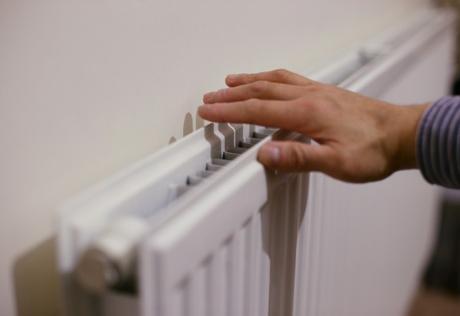
BE CAREFUL! Radiators can get really hot and you don’t want an unexpected trip to A&E to deal with!
Cool spots – especially nearer to the top of the radiator – mean that there could be air trapped inside and you’ll need to bleed that radiator.
Once you’ve found your cold spots, it’s time to get bleeding.
Step 3 – Bleeding The Radiators
Now switch off your central heating and allow the system to cool down – this will allow you to handle the radiators without scalding yourself or soaking the floor wet through.
At the top of the radiator you are going to bleed you’ll find a bleed valve – or nipple – at one end.
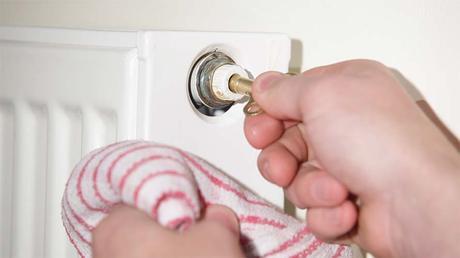
Insert the radiator bleed key into the groove of the bleed valve (you may be able to use a screwdriver here) and carefully turn it anti-clockwise – you should begin to hear a hissing sound, this is the air escaping.
Hold the radiator bleed key until no more air comes out and water begins to dribble from the radiator bleed valve.
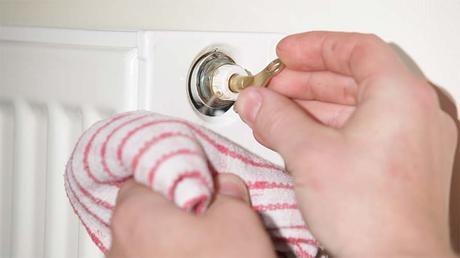
With more modern bleed valves, you may find that water emerges as a ‘jet’ of water and not a dribble, so you’ll need to be on your toes and close the valve quickly in the event of this happening when you bleed your radiator. Be careful NOT to over-tighten the radiator bleed valve, or you may cause damage.
Step 4 – Check The Pressure Of Your Heating System
Once you’ve closed the radiator bleed valve, go and take a look at the pressure gauge on your boiler (you could get someone else to do this).
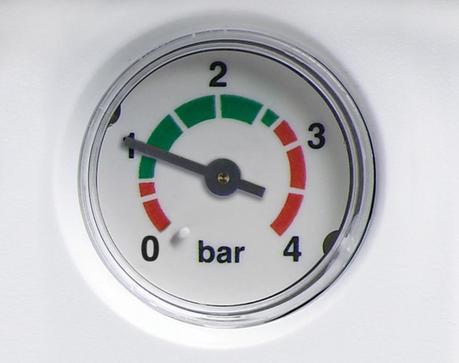
If the pressure is too low, you will have to use the lever on your boiler – the ‘filling loop’ – to top up the level of water in your central heating system.
Once you have done this, turn your heating back on and repeat the same checks as above. You may find that you have to bleed your radiator(s) and re-pressurise your system a couple of times to get the desired result.
Please Note – ALWAYS turn OFF the power to your boiler when re-pressurizing your central heating system.
What Is A Filling Loop & Where Will I Find It?
A central heating filling loop is the pipe that connects your central heating system to the mains water supply.
Your filling loop isn’t part of your boiler – but it will connect to it, so it will be nearby.
If you have an external filling loop, it will probably look something like this and you’ll have to turn the taps to allow water into the system.
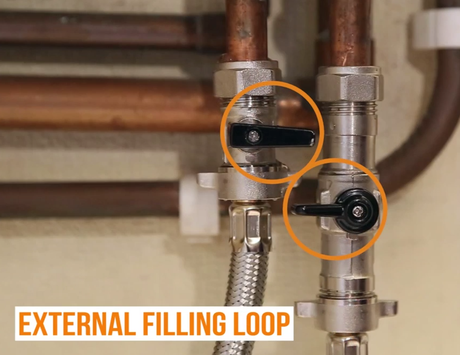
Don’t turn any taps other than those connected to the filling loop. The one’s you are looking for are normally black in color and may even have the words ‘filling loop’ on them.
Turn the taps slowly in order to safely control the flow of water into the system, being careful not to exceed the required level – you should hear water being fed through the inlet pipe and into your central heating system.
Alternatively, you might have an internal filling loop key attached to a panel at the bottom of your boiler – like the one in this video – or a couple of filling taps situated underneath, like this.
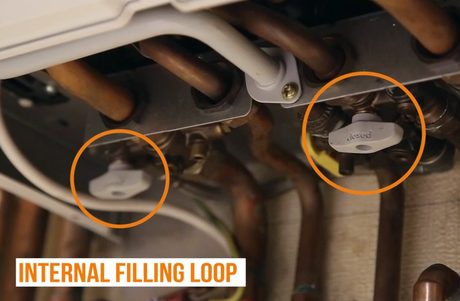
Please Note – Different boiler manufacturers and installers will recommend different optimum operating pressures for your boiler and central heating. If you are unsure of what these pressures are, please seek professional advice.
Improving Your Home Heating
When it comes to fuel bills, over 50% of the money we pay out goes towards heating and hot water needs.
Because of this, knowing how to bleed a radiator can be pretty useful when helping you to cut down on your heating costs. But there are a few other things that are worth knowing that can make your central heating system more energy efficient, helping you to keep the cash in your pocket.

Although common sense might suggest it’s a bit of a silly thing to do, switching your heating on in the spring and the summer – just as you do at colder times of the year – can actually be a good idea.
Just quickly flicking your boiler on for 10-15 minutes during the warmer months could help to prevent a boiler breakdown when the weather turns.
It’s also a good practice to keep your eyes peeled for any signs of trouble with the system. If you find your pressure drops repeatedly on your boiler, it may mean that you have a leak in a radiator or maybe your pipework – meaning you may have to call out a Gas-Safe registered engineer.
Getting an annual boiler service is also prudent practice, and at a cost of around £60, it is definitely better to be safe than sorry.
If you haven’t already, installing a thermostat onto your boiler is also a good way to save money. Setting it to a maximum temperature of around 60°C is really cost-effective and could save you around £30-a-year.
And last, but by no means least, is insulation. Loft insulation and proper draught-proofing around your windows and doors could give you a potential saving of around £300-a-year on your gas central heating bills.
Radiator Bleeding Video Guides
We humans are visual folk, so here are two handy videos on how to bleed a radiator and how to bleed a heated towel rail.
We’re sure you’ll be fine, but if you do get stuck, just refer to the videos. Good luck!
Let us know how you got on bleeding your radiators on Facebook, Twitter and in the comments below.
Till next time, Stay Safe & Happy Heating

